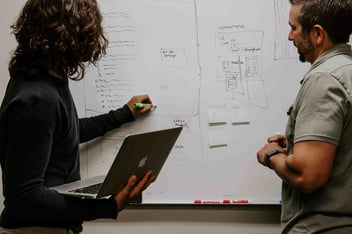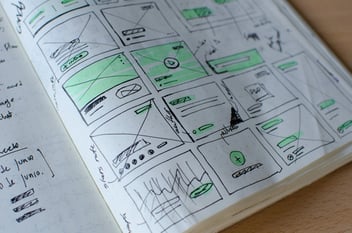So, you’ve made the decision to work with a UX design firm (or at least consider one) for your project. We're here to help you vet your options.
Related: Should You Hire a Designer or Work with a UX Agency? Here's How to Decide.
Maybe you’re designing something brand new, or maybe this is a redesign of an application with UX difficulties, like high support costs or low adoption.
It’s difficult to count the number of clients who have come to us because their software development shop — while equipped with some great engineers — just can’t design the UX worth a damn.
Either way, there are plenty of UX design firms out there who want to help. But that’s sort of the problem, isn’t it?

Clutch.co has nearly 3,000 firms listed in their UX Design Agency index. Plus, there’s no shortage of marketing agencies who claim they do this type of design as well.
So the question you’re facing now is how to properly navigate the ocean of potential vendors — who will all claim to be the best option — and select one who actually is capable of doing a great job.
I know it’s overwhelming. But have no fear; we’re here to help.
Here’s what you need to do.
First, Define Your Project Constraints
First things first. It’s time to get your constraints defined.
If I were in your shoes, I’d start by figuring out my budget and an ideal timeline for the project’s completion as soon as possible.
“What’s an average budget for a project like what I’m talking to you about?” and “How quickly can your team get started?” are two questions that can rule out some vendors really quickly.
That way you’re not wasting time going through an estimation process. Believe me, vendors are going to appreciate that transparency as well.
What else is important to you for this particular project? Is geography important? Is scale important because you have a lot of work to get done? Try to draw as many clear lines in the sand as possible to narrow your search.
From there, follow the checklist to assess the level of maturity and sophistication associated with a given vendor.
The UX Firm Checklist
Read Third Party Reviews
There’s a third-party review site for almost everything now, and the agency world is no different!
Clutch.co is the current leader in providing reviews on service providers for web design, development, and so on. So I’d check out a vendor’s profile there and see what past clients have to say about working with them. You can see one of our recent Clutch.co reviews here: DePalma Studios Earns a New Review On Clutch.
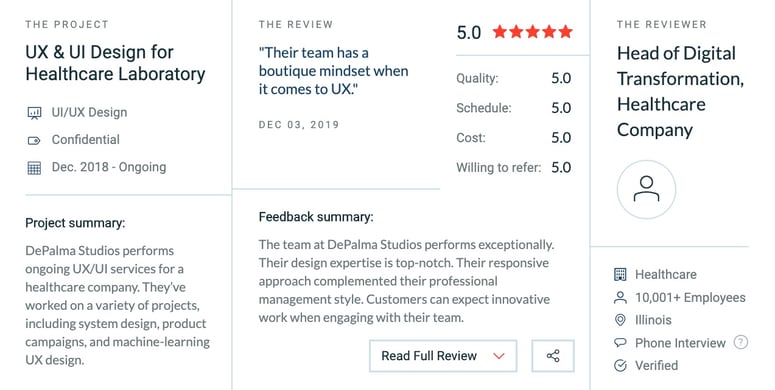
See the full list of DePalma Studios reviews on Clutch.co here.
From there, you can look at Google reviews, Trustpilot, and even sites like Glassdoor.
No, you’re not applying for a job, but how happy are their employees? Employee satisfaction and company culture can impact the quality of an agency's work.
While you're in digital due diligence mode, look at the company's social media pages. Are they posting regularly? Are they creating their content? An absence of these two areas is not necessarily a red flag, but an active marketing presence can also signal company health and legitimacy.
Ask for References
Ask vendors to provide you with 2-3 references and their contact information. Obviously, agencies can stack the deck with only happy clients, but this still helps you confirm that they have happy clients at all.
If they can’t supply any references, then that should be a gigantic red flag.
Side note from the agency’s perspective: Try to be reasonable about how many references you’re asking for, especially if your project is smaller. Remember, these are favors that the vendor is essentially cashing in with past clients.
What’s Their Experience Like?
Look into the bios of the people leading the UX team. The more experienced the leadership, the better.
Also, you should ask about the minimum requirements for hiring at a given agency to ensure you’re not paying a huge premium on a junior resource.
Vet the UX Firm's Processes
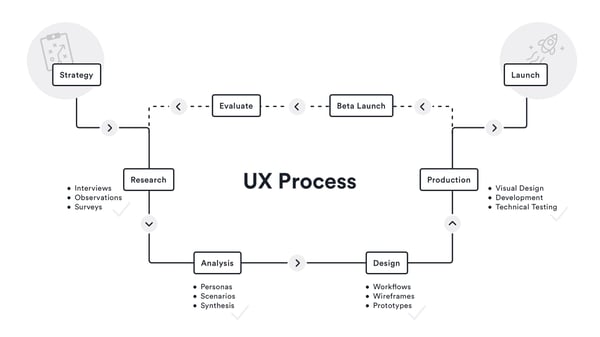
Great companies are consistent. That’s how they scale and stay profitable. And businesses only achieve consistency by following a well-engineered, battle-tested process.
UX Design is no different. Yes, it's a creative and artistic endeavor with a major scientific component.
If an agency is doing UX work for multiple clients, then having a reliable process is the only way they’ll be able to track progress, estimate timelines, and guarantee success.
Here are a few questions I would ask any vendor about their design process:
- “Which steps are the most non-negotiable in the design process?”
- “What is the importance behind each step?”
- "Can you give me an example where {example step} contributed to a project’s overall success?”
Look for Flexibility in the Design Process
Part of being a master at your craft means you can be light on your feet.
I would be cautious of agencies that are too rigid in their processes. In my experience, there’s almost always a path to improvement, but vendors need to be able to expand or contract the process relative to your budget and timeline.
If the agency has true expertise, it won’t shy away from the challenge.
Make Sure They Have Soft Skills
When you partner with an agency, you’re hiring all the people assigned to your project for a short time. And we all know how difficult hiring can be.
Just like you would in your usual hiring process, you’ll want to make sure the agency’s talent is a good fit for you and your team.
Unfortunately, assessing soft skills with only a handful of conversations isn't easy. I recommend pursuing two routes here:
1) Get a couple of conversations going with the project lead from the vendor's side.
Good UX firms will ensure their project leads are involved in the sales/estimation process so you can get to know them and feel more comfortable.
2) Look for contract terms that make it easy to exit the agreement if things go awry.
You should be able to cancel your project anytime and for any reason if you’re unhappy with how things are going.
Experienced firms know that when they experience attrition, it usually has more to do with the client being a bad fit. So they don’t want those projects anyway, hence the easy exit terms.
Ask About Their Estimation - How Did They Get There?
Every firm you engage will try and estimate the effort needed to complete the redesign on the front end. You should ask them how they calculated their estimation.
While this is always somewhat subject, top-tier agencies will try to remove subjectivity. These are the people you want to work with!
Also, be cautious of overconfidence in an estimation. There are loads of unpredictable factors at work during these projects. How much feedback are you going to have on designs? How much iterating will you want?
These are hard to predict for both the vendor and the client until the work begins.
Do They Have Front-end Development Expertise In-House?
Be wary of any UX Design project that doesn’t have a front-end developer adding input.
Even experienced UX designers can get a little crazy with their designs and develop something that would take an absurdly long time to build. Developers provide a much-needed check to this problem.
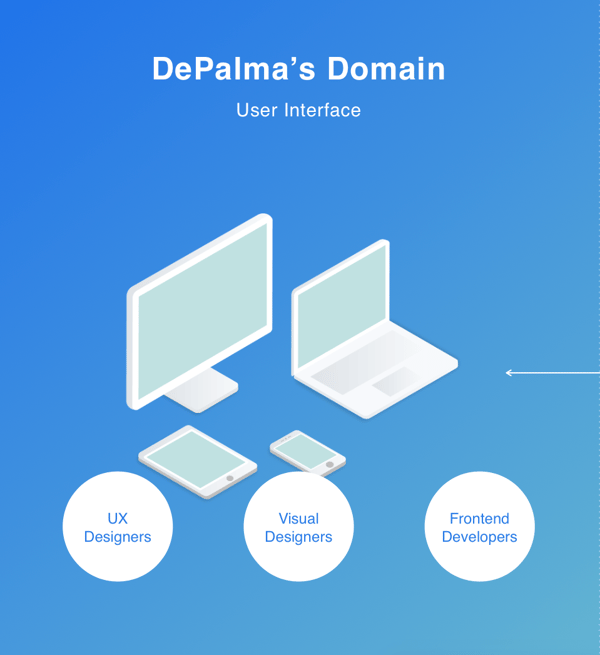
Ask questions like “Do your project leads have experience in front-end development?” or “Do front-end developers review your design work as a part of your internal process?”.
Do They Have Specialty Resources Available?
We’ve covered the skill gaps in UX Design many times on this blog, but this is yet another area where it can be helpful to understand.
Mature UX Design firms will have teams of designers with different skill sets that they can call on when necessary.
Among these skills are User Research, Workflow/Functional Design, Visual Design, and Content Strategy. Typically, UX Designers are strong in just a couple of these areas; it’s very rare to find a designer that can do it all.
Can They Scale?
If your project is large, you must evaluate the agency’s ability to scale up its resources.
This is really about analyzing a vendor’s recruiting capabilities and whether or not they have an operations infrastructure that will allow cost to scale as your team grows.
Great firms will have multiple recruiting channels to facilitate speed and possibly even multiple offices to access different geographic talent pools.
For Larger Projects
If you’re working on a big enough project, starting with one small part of the application may be worth it first.
We recommend this approach to almost all of our clients who come to us with big projects.
It works like this: we start small and take a piece of your project — typically the design — through our process so you can understand how it works, assess the results, and familiarize yourself with our team.
Then, if you're satisfied, we move forward with the rest of the process.
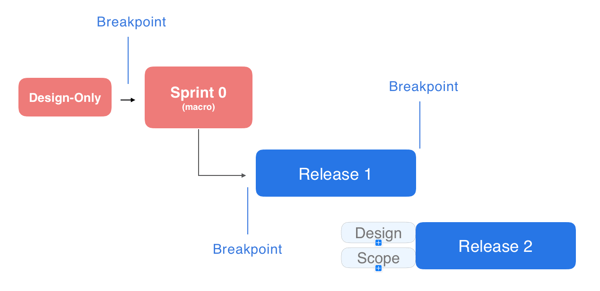
There’s no better way to assess how a vendor performs against the criteria I’ve mentioned than to get started on the project.
***
Finding the right fit can be very challenging. After all, you’re probably dealing with someone who wants to close a new client.
I work at a UX design firm myself, but I’ve found that helping people evaluate us and our competition so that they can make the best decision is the best course for all involved.
This advice comes from an experience I’ve gathered firsthand throughout my work with agencies.
I hope you find it helpful.




